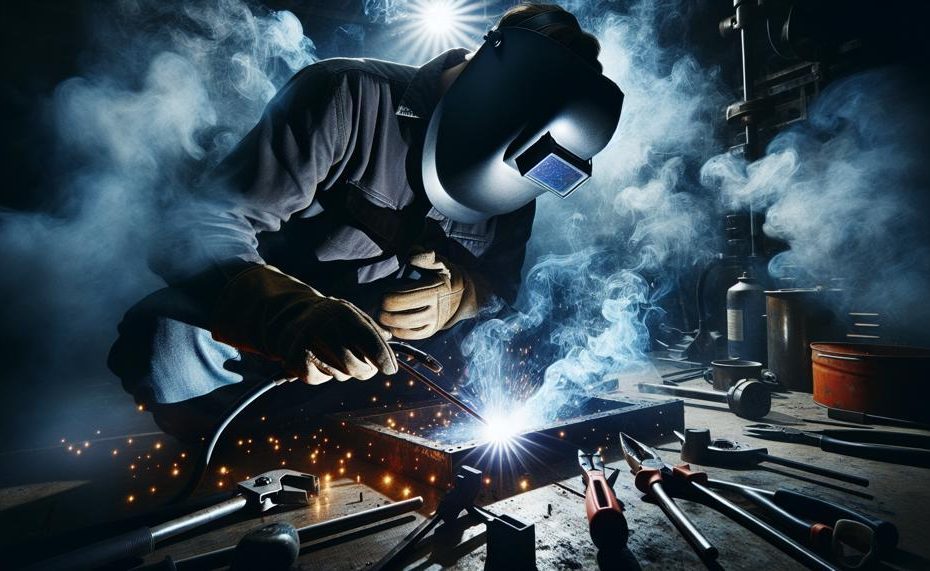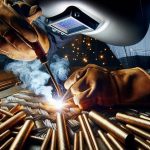If you’re new to the world of welding, you may have heard this term thrown around but are unsure of its meaning. Or perhaps you’re a seasoned welder looking to expand your skills and knowledge. Whichever category you fall into, we’ve got you covered.
MIG (Metal Inert Gas) welding is a widely used technique that harnesses electricity to create an arc between a consumable wire electrode and the metal being welded. This method is renowned for its versatility, ease of use, and ability to produce high-quality welds in various types of metals.
In this post, we will delve into the fundamentals of MIG welding and cover everything from essential equipment needed to techniques and tips for achieving flawless welds.
So, put on your safety gear and let’s get started. Here’s what we’ll be exploring:
- What exactly is MIG welding?
- The necessary equipment for MIG welding
- Techniques for successful execution of MIG welding
- Tips for achieving robust and immaculate welds
- Common mistakes to avoid while MIG welding
- Advantages of using MIG welding over other techniques
- Applications of MIG welding in different industries
Whether you’re interested in DIY projects or pursuing a career in welding, understanding the intricacies of MIG welding will prove invaluable.
So without further ado, let’s dive in and gain a deeper understanding of this essential technique.
Contents
What is a MIG welder?
When it comes to welding, the type of electrode used to create the arc is what sets a MIG welder apart from other types, such as stick and TIG welders. While MIG welding utilizes a consumable wire electrode, stick welding and TIG welding use non-consumable electrodes.
This distinction results in different techniques, applications, and benefits.
| Type of Welder | Electrode Used | Main Applications | Benefits |
| MIG Welder | Continuous solid wire | Industrial, automotive, construction | Fast, versatile, minimal post-weld cleanup |
| Stick Welder | Consumable flux-coated rod | Metal fabrication, maintenance repair | Portable, suitable for outdoor use |
| TIG Welder | Non-consumable tungsten rod | Fine metal welding, aerospace industry | Precise control, clean welds on thin materials |
Aside from the electrode type, each type of welder also has its own unique set of equipment and techniques. MIG welding requires a power source, wire feeder, and welding gun. On the other hand, stick welding uses a handheld electrode holder while TIG welding utilizes a foot pedal to control the welding current.
Furthermore, different types of welders have varying levels of difficulty and skill requirements. MIG welding is generally considered easier for beginners due to its continuous wire feed and smooth arc.
Stick welding requires more practice and skill to achieve strong and clean welds, while TIG welding is known for its precision and requires advanced welding techniques.
Why do we need MIG welders?
MIG welding is highly favored by both professionals and beginners due to its numerous advantages over other welding methods. Its versatility, efficiency, affordability, safety, and ease of use make it the top choice for welders of all levels.
Let’s take a closer look at how MIG welding compares to stick and TIG welding in terms of these key factors.
| Advantage | MIG Welding | Stick Welding | TIG Welding |
| Versatility | Can be utilized on a wide variety of materials and metals. | Restricted to specific types of materials and metals. | Limited to certain types of metals only. |
| Speed and Efficiency | Uses continuous wire feed for faster and cleaner welds. | Requires frequent stops and starts, resulting in slower welding. | Takes longer to produce welds due to its precision technique. |
| Cost-effectiveness | Equipment and consumable wire electrodes are relatively affordable. | The equipment can be costly, and filler materials are expensive. | The equipment is more expensive, and the tungsten electrode needs frequent replacement. |
| Safety | Produces minimal smoke and fumes thanks to the use of inert gas. | Produces more smoke and fumes compared to MIG welding. | Produces more smoke and fumes compared to MIG welding. |
| Ease of Use | The continuous wire feed and stable arc make it easier for beginners to learn. | Can be more challenging for beginners due to its precise technique. | The most challenging technique to master. |
Why do we need MIG welders?
MIG welding is an essential skill for any welder, whether you are a professional or a beginner. The advantages it offers over other welding methods make it a must-have technique in your arsenal. Let’s delve deeper into these benefits and why we need MIG welders.
Firstly, MIG welding is incredibly versatile, allowing you to work with a wide range of materials and metals. This flexibility makes it a suitable choice for various projects, from automotive repairs to metal fabrication.
In addition, MIG welding is highly efficient and saves you time and effort. Its continuous wire feed allows for faster and cleaner welds, making it ideal for large-scale projects. On the other hand, stick welding requires constant stopping and starting, resulting in slower progress.
Moreover, MIG welding is cost-effective compared to other methods.
What can you use MIG welders for?
MIG welding is a versatile process that can be used with a wide range of materials, making it a popular choice for various projects. For example, it is commonly used in the automotive industry for repairing and fabricating parts such as body panels, frames, and exhaust systems.
This process allows for more creativity and flexibility in design compared to other welding methods, making it suitable for artistic projects like creating sculptures, metal furniture, and other artistic pieces.
Furthermore, MIG welding is widely used in the construction industry for joining structural steel, creating metal frames and supports, and welding pipes and beams. Its fast speed and high efficiency make it ideal for large-scale construction projects. In addition, many manufacturers use MIG welding to produce metal products such as machinery, appliances, and furniture.
Its ability to weld a variety of metals makes it suitable for working with different types of vehicles and materials.
Some of the common materials that can be welded using a MIG welder include carbon steel, stainless steel, aluminum, copper, cast iron, magnesium, nickel, and silicon bronze. Each of these materials has its unique properties that make them suitable for specific industries and applications.
For instance, carbon steel is known for its durability and strength, making it commonly used in construction and automotive industries.
On the other hand, stainless steel is corrosion-resistant and versatile, making it ideal for industries such as food, medical, and automotive.
To provide a more comprehensive understanding of the materials that can be welded using a MIG welder, here is a table summarizing the common materials along with their properties:
| Material | Properties |
| Carbon steel | Durable and strong – commonly used in construction and automotive industries |
| Stainless steel | Corrosion-resistant and versatile – commonly used in food, medical, and automotive industries |
| Aluminum | Lightweight and strong – commonly used in aerospace and automotive industries |
| Copper | Highly conductive and malleable – commonly used in electrical wiring and plumbing |
| Cast iron | Tough and resistant to wear – commonly used in machinery and automotive parts |
| Magnesium | Lightweight and strong – commonly used in aircraft and automotive industries |
| Nickel | Highly corrosion-resistant and heat-resistant – commonly used in chemical and nuclear industries |

How does the MIG welding process work?
The art of MIG welding, known as Gas Metal Arc Welding (GMAW), is performed by generating an electric arc to fuse two metal pieces together.
This is accomplished by using a welding gun to feed a solid metal wire electrode. The electrode creates a powerful heat source that melts the metal and forms a strong bond between the two pieces.
This process is widely used in various industries due to its efficiency, flexibility, and ability to produce immaculate welds.
How does the MIG welding process work?
MIG welding is considered beginner-friendly. It offers an easier and cleaner experience than other welding methods. However, this does not mean that stick welding has become obsolete. Stick welding is also known as Shielded Metal Arc Welding (SMAW).
Many professionals still rely on stick welding. They value its versatility and applications in different scenarios.
MIG welding may be easier for beginners. However, it’s important to note that the learning curve for this process can vary depending on the individual’s skill level. For instance, while some may find it easier to control the welding gun and create clean welds, others may struggle with maintaining proper technique and precision.
Furthermore, one of the significant benefits of MIG welding is its ability to handle a wide range of materials and thicknesses.
This makes it ideal for use in industries such as automotive, construction, and manufacturing, where different types of metals are commonly used.
Conclusion
In conclusion, MIG welding is a highly versatile and efficient technique that utilizes electricity to create an arc between a consumable wire electrode and the metal being welded.
Its ease of use has made it a popular choice among beginners and professionals in various industries. Through this blog post, we have delved into the fundamentals of MIG welding, explored its applications, and highlighted its advantages over other techniques.
Whether you’re a DIY enthusiast or pursuing a career in welding, mastering the art of MIG welding will prove to be invaluable.
So, don your safety gear and start honing your skills – with MIG welding, the possibilities are limitless.





